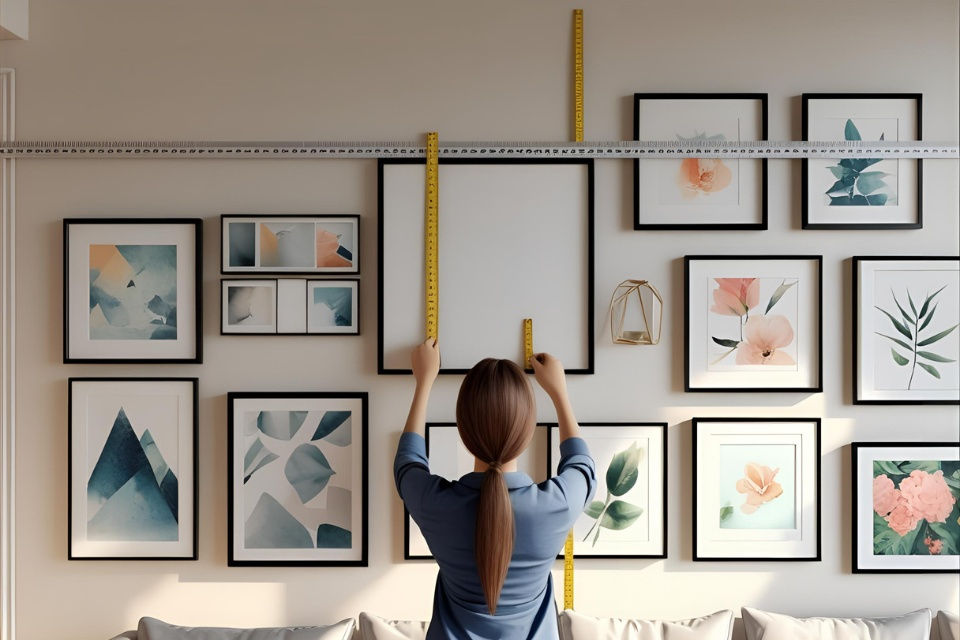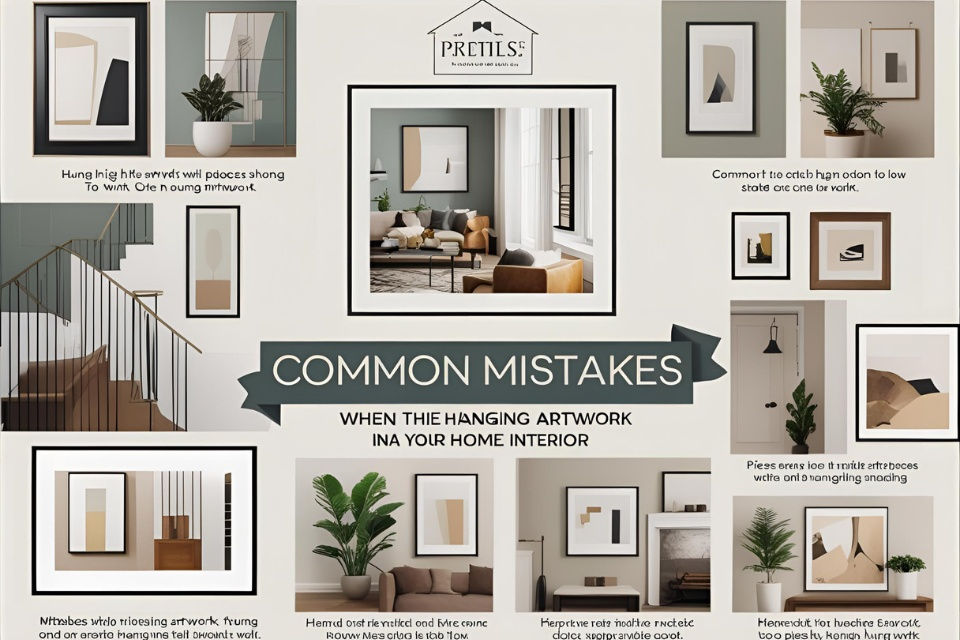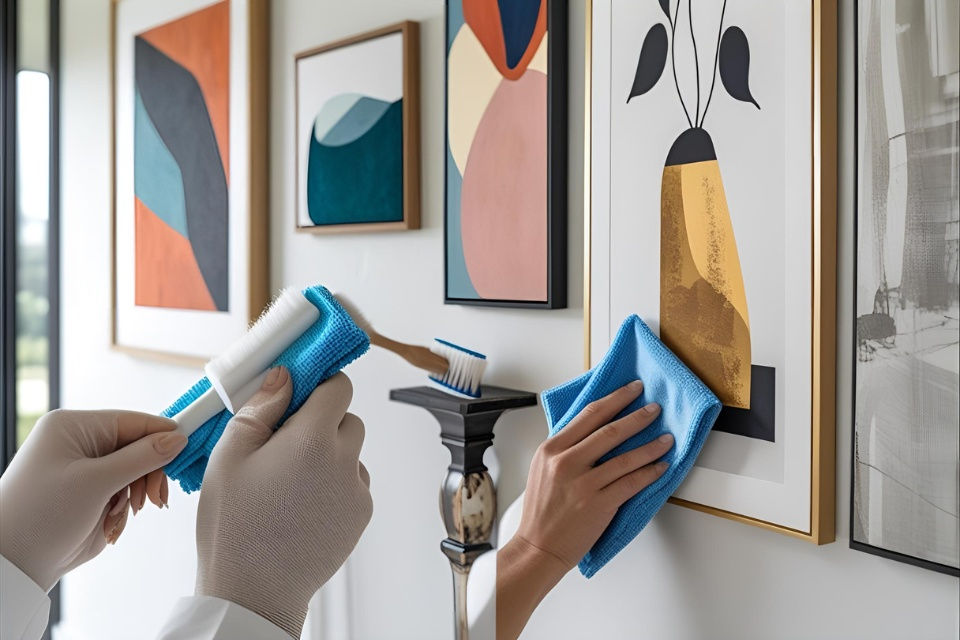How to Hang Art: Tips, Tricks, and Common Mistakes to Avoid
- Home2decor

- Jul 7
- 11 min read
How to Hang Art: Tips, Tricks, and Common Mistakes to Avoid by Interior Designers in Goa
Understanding the Importance of Art Placement
Art placement plays a pivotal role in defining the aesthetic appeal of any space. Whether it is a cozy living room or an elegant dining area, the positioning of art can significantly affect the overall atmosphere. One of the essential considerations when hanging art is the sightlines within the room. This refers to the visual paths that guide the eye throughout a space, ensuring that art does not obstruct essential features or pathways. Strategic placement allows art to be the focal point, drawing attention and enhancing the atmosphere.
Creating a focal point is another fundamental aspect of art placement. When selecting pieces for a room, it is crucial to consider how they interact with surrounding furnishings and decor. Larger artworks, for instance, can serve as striking focal points that command attention and dictate the space's overall theme. By choosing pieces that resonate with the room’s style, homeowners can create a harmonious balance between the artwork and the interior environment. This is particularly important when integrating art into residential spaces, as Interior designers in Goa often advise on aligning art with personal taste and the established decor.
Moreover, the placement of art can reflect one’s personal style and preferences. An art piece not only serves as decoration but also as a representation of the homeowner's personality. Through careful selection and placement, individuals can unveil an artistic expression that showcases their values, experiences, and interests. For those looking to enhance their interiors, enlisting the expertise of famous interior designers in Goa can provide invaluable insights on how to optimize the use of art in various settings.
In conclusion, the strategic placement of art is vital to creating an aesthetically pleasing and personalized environment. Taking into consideration sightlines, focal points, and harmony with existing decor can significantly transform a space and give it a character that reflects the homeowner’s unique style.
Choosing the Right Location for Your Art

Determining the ideal location for your artwork is a critical step that can greatly enhance the overall aesthetic of a room. First and foremost, consider the wall size. Large art pieces may overwhelm a small wall, while smaller works may get lost on expansive surfaces. A balanced approach ensures that the artwork has enough presence without feeling cramped or insignificant. Interior designers in Goa often emphasize this aspect by recommending a scale that complements the room's proportions.
Next, evaluate the lighting conditions in your space. Natural light can significantly change how colors are perceived, so you must assess whether your chosen location receives sunlight throughout the day. Direct light may fade your artwork over time, while dimly lit areas can render the pieces unnoticeable. Utilizing specific light fixtures or strategically selecting interior designers in Goa for home can ensure that your art receives the right illumination to enhance its visual impact.
Another essential factor is the viewing height, which affects how easily the artwork can be appreciated. Generally, artwork should be hung at eye level, around 57 to 60 inches from the floor, although adjustments may be necessary based on individual preferences. For gallery-style arrangements, maintaining consistent spacing between pieces can create a cohesive display. Engaging the expertise of famous interior designers in Goa can help you tailor these guidelines to suit your unique environment.
In conclusion, by paying attention to wall size, lighting, and viewing height, you can choose the perfect location for your art. This careful consideration will not only enhance the appeal of your home but also ensure your artwork is showcased in the best possible light, resonating with the aesthetic vision curated by the best interior designers in Goa.
Determining the Right Height to Hang Art

When it comes to hanging art, one of the most crucial factors to consider is the height at which the artwork is displayed. The '60-inch rule' is a widely accepted guideline that suggests the center of the art should be approximately 60 inches from the floor. This standard height is effective because it aligns with average eye level, making the artwork easily viewable for most people. Interior designers in Goa often emphasize the importance of this rule when assisting clients in both residential and commercial spaces.
While the 60-inch rule works well for many settings, adjustments may be necessary depending on the specific environment. For instance, in a gallery setting where viewers are expected to walk around and observe the art from different angles, the height may vary to enhance visibility and engagement. In contrast, for homes, especially in living rooms or dining areas, adhering to this guideline can create a cohesive and inviting atmosphere. A key consideration for interior designers in Goa for home projects is to ensure that the artwork complements the surrounding furnishings and architectural details.
Additionally, it is important to take into account the size of the artwork itself and the surrounding decor. Larger pieces may benefit from being hung slightly higher, while a gallery wall featuring multiple smaller works can create visual interest when placed at varying heights. Effective collaboration with reputable interior designers in Goa can lead to innovative solutions tailored to individual spaces. As you explore options among the top 10 interior designers in Goa, consider how they advocate for proper art placement to enhance the overall aesthetics of your environment.
In conclusion, determining the right height for hanging art is essential for creating a visually appealing space. By adhering to the 60-inch rule while considering the unique characteristics of the environment, homeowners and art enthusiasts can ensure that their selections are displayed effectively and stylishly.
Selecting the Appropriate Hardware for Hanging Art

When it comes to hanging art, the hardware you choose plays a crucial role in ensuring that your pieces are displayed safely and securely. Among the most common options available to homeowners are nails, picture hooks, and wall anchors. Each type of hardware has its pros and cons, and understanding them is essential for selecting the right type based on the weight and size of your artwork.
Nails are perhaps the most straightforward option for hanging lighter art pieces. They are easy to use and can be driven directly into the wall without any additional tools. However, they may not provide the best support for heavier artwork. For pieces that weigh more than a couple of pounds, picture hooks are a more suitable alternative. These hooks can hold substantial weight and are available in various sizes, making them ideal for both small and large frames.
Wall anchors are a solid choice for heavier artworks, especially if you are hanging them on drywall. They distribute the weight of the art more evenly across the wall, reducing the risk of damage. To use wall anchors, you will need to drill a hole into the wall, which may not be ideal for all homeowners. However, they are often necessary for larger or more valuable pieces to ensure stability.
When selecting hardware, consider the size and weight of your art. For frames that are especially large or bulky, you may want to utilize multiple hooks or heavy-duty wall anchors to keep them secure. Additionally, take into account the wall material; certain hardware performs better on different surfaces. For instance, masonry walls may require specific types of anchors to ensure a secure fit. By evaluating these options, you can choose the appropriate hardware to perfectly hang your artwork while adding aesthetic value to your space.
Creating a Gallery Wall: Tips and Tricks

Creating a gallery wall can be a rewarding way to display your art collection and personalize your space. It allows for a unique expression of your style, while also showcasing the creativity of various artists. To curate a cohesive gallery wall, start by selecting a theme that resonates with you; consistency in color, subject matter, or artistic style can create harmony. You may wish to focus on a particular era, artists, or even color palette, as this will guide the overall visual impact.
When it comes to layout ideas, take the time to experiment with different configurations. A grid layout creates a modern and clean appearance, while a salon-style arrangement allows for a more eclectic feel. To visualize your layout before committing, consider laying the art pieces on the floor or using painter's tape to outline the frames on your wall. This will ensure that spacing is effective and pleasing to the eye. A common spacing guideline is to keep approximately 2-5 inches between frames, depending on their size and the overall design you wish to achieve.
Mixing different styles and frame types can add depth and character to your gallery wall. Integrating various frame styles, such as vintage next to contemporary, can create interest and a sense of textural variation. As you select frames, consider that the best interior designers in Goa often emphasize the importance of unifying elements, such as color or style choices, even within differing shapes. If you are unsure about your choices, researching the best interior designers in Goa can provide inspiration and guidance tailored to your personal aesthetic.
By following these tips and tricks, your gallery wall can become a stunning focal point that reflects your artistic journey. A well-planned gallery layout not only enhances the beauty of your home but also speaks to your tastes and preferences, much like the creations of famous interior designers in Goa.
Common Mistakes to Avoid When Hanging Art

Hanging art can dramatically elevate a space, but common mistakes can undermine this effort. One of the most prevalent errors is hanging artwork at the wrong height. Ideally, the center of the artwork should be at eye level, generally around 57 to 60 inches from the floor. If hung too high or too low, the art can become visually unappealing and detract from the overall aesthetic of the room. This is particularly crucial for interior designers in Goa, where the unique coastal environment and architecture demand thoughtful curation of art placements.
Another mistake often made is failing to consider the scale of both the art and the space. A large piece of art can dominate a small wall, while a small piece might get lost on a larger canvas. It is important for homeowners to analyze the proportions and choose artwork that complements the size of the surrounding elements, such as furniture and architectural features. This approach aligns with the strategies employed by famous interior designers in Goa, who expertly translate local styles into visually harmonious designs.
Overcrowding a wall with art is yet another frequent pitfall. While a gallery wall can be visually striking, too many pieces can create visual chaos. Instead, aim for balance by spacing artworks evenly and allowing breathing room between them. Interior designers in Goa for home projects often advise limiting the number of artworks on a wall to maintain clarity and focus. Incorporating a few strong statements rather than numerous smaller pieces can enhance the overall impact and ensure the art serves as a focal point rather than a distraction.
By avoiding these common mistakes—hanging at the wrong height, not considering space scale, and overcrowding—you can ensure a polished look that showcases your art effectively. Partnering with the best interior designers in Goa can also provide expert guidance to bypass these missteps entirely.
Maintenance and Care for Hung Art

Once you have successfully hung your artwork, maintaining its condition becomes essential in preserving its beauty and longevity. Regular care not only enhances the aesthetic value of your space but also ensures that your investment, particularly if the artwork is from famous interior designers in Goa, remains intact over time.
Firstly, it is advisable to periodically clean the art pieces to remove dust and dirt. For framed art, utilizing a soft, dry microfiber cloth can effectively eliminate dust without causing scratches. In the case of paintings, especially those with textures, a gentle brush can help reach crevices. It is typically best to avoid cleaning products that may contain harsh chemicals which could damage the surface of the artwork. If you're unsure about the right cleaning technique, consulting with professional interior designers in Goa for home would be beneficial, as they often provide specific guidance tailored to various art types.
Additionally, positioning artworks away from direct sunlight can help prevent fading, a common issue that affects many pieces. The ultraviolet rays can significantly alter colors over time. To combat this, consider using UV-filtering glass for framed pieces or displaying your artwork in areas with controlled lighting. It's also prudent to keep the humidity levels in check; excessively humid environments can lead to mold growth on canvas pieces. Employing a dehumidifier in rooms where art is displayed helps maintain a stable environment.
Lastly, scheduling periodic checks is a wise practice. Inspect your artwork for any signs of damage or deterioration, and promptly address any issues. This preventive maintenance can prolong the vibrancy and life of your collection, ensuring that even the best interior designers in Goa would approve of its care.
Incorporating Lighting to Enhance Your Artwork

Effective lighting is a pivotal element when it comes to showcasing art within interior spaces. Proper illumination not only accentuates the design and detail of artwork but also creates an atmosphere that complements the overall theme of the room. Consequently, understanding how to harness both natural and artificial lighting becomes essential for achieving a polished look.
Natural light can breathe life into a space, revealing the true colors and textures of art pieces. When planning the arrangement, consider positioning artworks near windows or in areas where sunlight is prevalent. However, it is crucial to manage natural light carefully, as prolonged exposure can cause fading over time. Using UV-filtering glass can be an effective solution in preventing damage while still gaining the benefits of natural illumination.
On the other hand, artificial lighting plays a significant role in situations where natural light is not viable. Options such as spotlights and sconces can guide attention to specific artworks, effectively creating a focal point within the room. Adjustable LED lights are particularly popular among interior designers in Goa for their versatility and energy efficiency. They allow for varying intensities and color temperatures, ensuring that each piece is showcased in the most flattering manner. Well-placed wall sconces can also provide a warm ambiance, complementing the artwork's texture without overpowering it.
Moreover, to maximize the visual impact of art, consider layering different lighting sources. This technique adds depth and interest to the space. Using a combination of ambient, task, and accent lighting can help achieve a balanced and cohesive look. Whether one is searching for the best interior designers in Goa or renowned names among famous interior designers in Goa, prioritizing lighting can significantly enhance the overall presentation of artwork.
In summary, well-thought-out lighting is crucial when displaying art. It not only enhances the visibility of individual pieces but also contributes to the overall aesthetic of the home, making it a worthy consideration for anyone interested in interior design in Goa.
Final Thoughts and Inspiration
As we conclude our exploration of the art of hanging art, it is essential to reflect on the key takeaways that can enhance your experience. The journey of displaying art is not merely about positioning pieces on a wall; it is a profound form of self-expression that can transform a living space into a manifestation of your personality. Whether you are seeking guidance from expert interior designers in Goa or planning to curate your collection independently, keep in mind the core principles of balance, scale, and context.
The first step towards a successful art-hanging endeavor is to understand the importance of choosing the right location, considering lighting, and ensuring that your artwork resonates with the overall aesthetic of your interior design. Famous interior designers in Goa often emphasize the significance of creating a cohesive look that ties together various elements of a room. Therefore, when selecting your pieces, think about how they interact with your furniture and decor.
Inspiration can come from various sources, whether it is the minimalist approach taken by top 10 interior designers in Goa or the vibrant, eclectic styles that reflect personal stories. As the renowned artist Henri Matisse once said, "Creativity takes courage." Embrace your creativity—there are no rigid rules when it comes to art. Allow your instincts to guide you and feel empowered to experiment until you find the arrangement that speaks to you.
Ultimately, the goal is to evoke emotions and spark conversations through your art. So, as you set out on this artistic journey, remember that art hanging is a reflection of who you are. Trust in your vision, and don’t hesitate to consult with the best interior designers in Goa if you seek professional insight. Take pride in your space, and let it resonate with your unique taste and style.






Comments